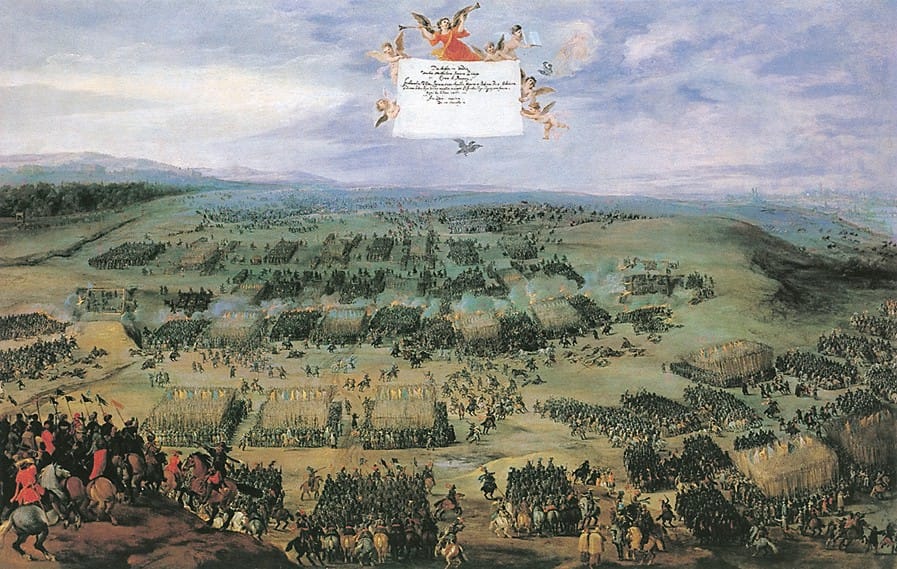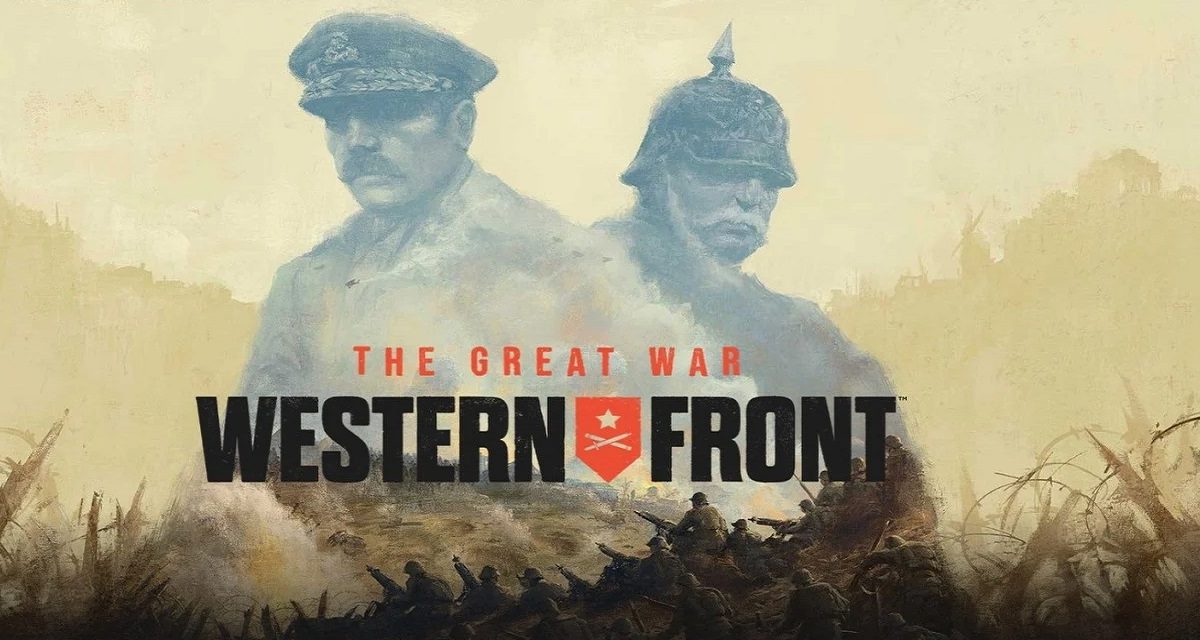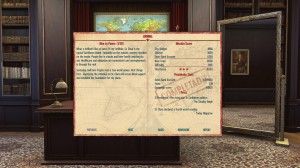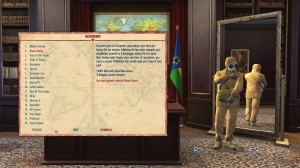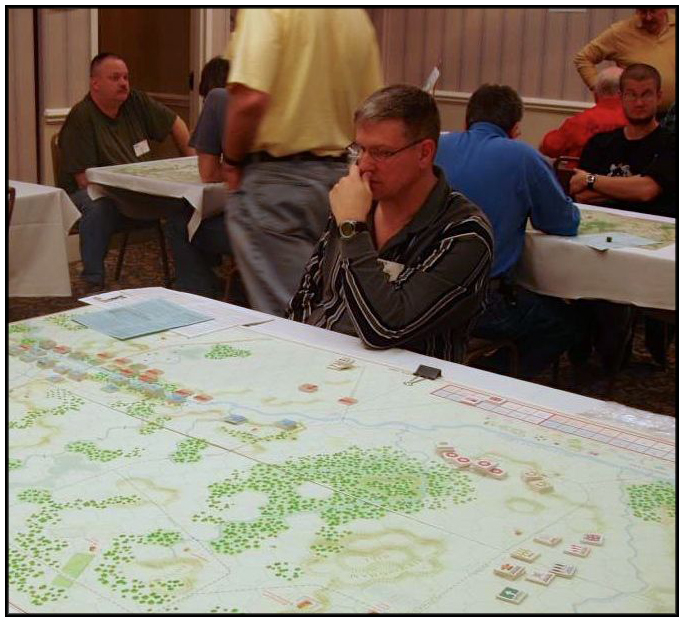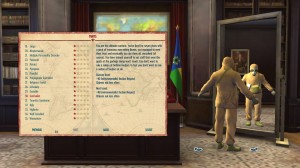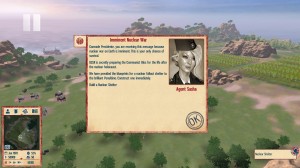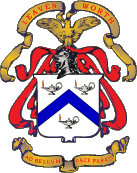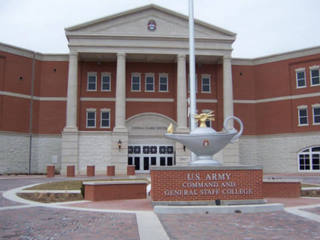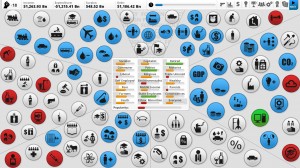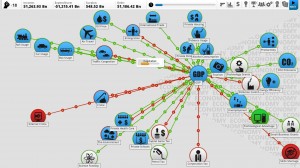Tag Archives: Simulation
Tropico 4 AAR – Last Isla St. Clara Part 1
I love playing Tropico 4. The easy salsa music contrasted with sharp, cynical political caricatures makes it a great way for me to kick back and have fun. I’ve managed to play the campaign from start to finish already, but today I wanted to share some of my enjoyment of the game in an AAR. Playing the game end to end forced me to solve problems sometimes with significant handicaps. The great thing about Tropico is how open-ended it is. There are often many ways to solve a particular problem. Today, I’m going to have some fun playing around and see how things go in the first mission of the campaign.
I begin by selecting my avatar. I choose a custom one. I purchased the Apocalypse DLC so I have access to some extra traits that don’t come with the base game. Of course I have to dress up in the hazmat suit. It’s a given. Nothing says, “I’m a petty third world dictator” like running around with a gas mask on. Before the player can get down to the business of gaming he needs to do more than pick out an avatar. The player also needs to select a background, rise to power, and three traits.
My background is that of Booze Baron which gives me double the prices for selling rum. However it comes at a cost – I lose 5% respect from the religious faction. My path to power is Elected as a Capitalist. This gives me bonuses to liberty, production, relations with the US and a bonus to the Capitalist faction. For the three traits I pick Patriot (which gives me a bonus with the Nationalist faction and native-born Tropicans), Scholarly (which gives me a bonus for worker training speed), and Survivalist (an add-on from the DLC which helps my citizens consume less food and gives me a bonus with the Environmentalist faction).
With that the game begins.
January 1950
Although the game comes with a tutorial even after you start playing the regular campaign periodically hints will pop up to help you along. Usually they’re good advice, but the game is open-ended enough that you don’t always need to take that advice. Here I am being shown what is in effect the game’s translation of Maslow’s Hierarchy of Needs: Food, religion, health care, homes, fun. If you prioritize your spending along those lines you’ll rarely go wrong. Tropico is also an economic simulator in addition to being a political sim. Wise investment can create a robust and growing economy. Poor investment will put you in a spiral of bankruptcy from which your small island nation cannot recover. Notably absent in that list of priorities is jobs. However, we’ll get to that.
Interview with COL(R) Eric Walters, USMC
This month, we have a fantastic interview with retired USMC Colonel Eric Walters. Well-known in professional wargaming circles as a supporter for great integration of wargames into training, COL(R) Walters graciously gave us a few minutes of his week to answer some questions and tell some war stories.
Interview by Brant Guillory, 9 November 2013
Can you give us a little bit of your military background in the Marines? And don’t be afraid to get technical – our audience is pretty savvy on organizational details!
I first joined as a tank officer and served as both a tank platoon and an amphibious tractor platoon commander, subsequently serving as a company commander in a maintenance battalion. I switched my Military Occupational Specialty to serve as a Marine Air Group Task Force Intelligence Officer and I did that job the last 25 years of my career. In that job I was lucky enough to serve in a wide variety of positions at that tactical , joint task force, subunified and unified command, and national levels. Most recently I served as the Director of Intelligence for the largest humanitarian assistance/disaster relief operation in the world—the aftermath of the 26 Dec 2004 Indian Ocean tsunami—and as the senior intelligence officer for 3rd Marine Aircraft Wing during the invasion of Iraq in 2003. One of my bosses at 3d MAW, Charlie Bolden, is presently serving as the Director of NASA, while my wartime commander, Jim “Tamer” Amos, is now Commandant of the Marine Corps. I guess they somehow succeeded in spite of me!
I did two “wargaming” tours in the military. One was as the intelligence officer for the II MEF Wargaming Center, basically designing Command Post eXercises (CPX) using computer wargames, manual wargames, and Tactical Exercises Without Troops (TEWTs) where only command posts went to the field to practice combat decisionmaking. The second was as the intelligence planner for the world’s largest CPX in Korea, ULCHI-FOCUS LENS; my job was writing the exercise scenario, designing the simulation-intelligence system interfaces, and executing intelligence control during the conduct of the exercise.
How did you pick up wargaming as hobby and how did you start to integrate wargaming into your assignments within the Marines?
In 1973 or so I was a young teenage model ship builder and went to a hobby store to purchase yet another 1:700 waterline series plastic kit of a WWII Japanese aircraft carrier when I spied a copy of Avalon Hill’s MIDWAY game. I bought that instead of the model kit and subsequently became obsessed with wargaming, never building another plastic model ship again. I used wargaming as a junior officer to teach Marines tactics and was lucky that the institution had its own manual games it employed in training. In the late 1980s we used a military miniatures game played on molded plastic terrain boards, TACWAR, to teach tactics from company to battalion level. We had a board game system called STEEL THRUST to exercise regimental and division staffs, played on paper maps. It took a lot of training and practice to use these wargame-based training devices well. Far more popular was the computer-assisted CPX supported by the Tactical Warfare Simulation Evaluation and Analysis System (TWSEAS) since it didn’t take a lot of customer unit familiarization training and overhead to use.
Tropico 4: Apocalypse – PC Game DLC Review
Developer: Haemimont Games
Publisher: Kalypso
Author: Jim Zabek
Sandy beaches, tropical islands, piña coladas, tourists, and perky salsa music. No, I’m not day dreaming like the Zac Brown Band, I’m playing Tropico 4’s latest DLC, Apocalypse. Apocalypse offers a single new mission, How I Learned to Love the Bomb, a new skin for El Presidente, a new trait, Survivalist, and a new building, the Fallout Shelter.
I hadn’t played Tropico 4 in over a year but when the new DLC came out I figured I’d drop $5 for it and see how it treated me.
I loved it. The scenario weighs in at 168% of normal difficulty and it took me all weekend to beat the mission. True to its roots I was faced with all the normal challenges of running a banana republic. Elections are held every 10 years (unless I were to take totalitarian steps against them), my people needed to be fed, sheltered, and their economy managed. The happiness of the various political factions was always hanging in the balance and there was never a point where someone wasn’t unhappy with how I was running things.
But in addition to the normal challenges faced in Tropico 4, the Apocalypse DLC placed me in new and dangerous territory: a tip from Agent Sasha informed me that nuclear war was “imminent.” Her definition of imminent and mine might differ slightly (some decades passed before I was able to win the scenario) but, as will all things Tropican, you can’t take things too seriously. Setting the plot, giving me a plausible sense of urgency, and plopping an extra $30,000 into the Tropican Treasury, my first task was to build the new building, a nuclear bomb shelter. Easy enough. With that out of the way the real work began.
At its surface the objective to win the scenario seems easy: recruit four political factions to join you in the shelter. In practice this is more difficult. Creating policies that make you popular with a particular faction don’t help. Instead you have to accomplish a series of what otherwise might appear to be “optional” tasks. None are particularly easy or cheap.
(SPOILER ALERT)
Interview with Dr James Sterrett, US Army Command and General Staff College
Dr Sterrett is the Deputy Director of the US Army Command and General Staff College’s Digital Leader Development Center’s Simulations & Exercises Division. Yes, that’s a loooooooong title. The short version is: he uses wargames for training, and gets paid for it. He’s also an avid hobby wargamer, and has spent about 7 years struggling to come to grips with the differences between “games” and “simulations” (pretty much since I introduced him to “Brant’s Theory of the Differences Between Games and Simulations”). In spite of this, he agreed to have a chat with us about his role at Ft Leavenworth.
Interview by Brant Guillory, 5 October 2013
Can you please give us an overview of the Digital Leader Development Center’s Simulations & Exercises Division, and what role they fill at the Command and General Staff College (CGSC)?
The Digital Leader Development Center (DLDC) supports CGSC’s exercises. DLDC has three major functions: providing and supporting Army and Joint mission command systems; providing and supporting simulations and exercise planning; and providing an exercise network for the simulations and the command systems.
Thus, Simulations & Exercises Division’s foremost job is exactly what it says on the label: put on the exercises the instructors want: selecting the best simulation for the job, ensuring it is ready to deploy into classrooms, preparing support materials, building scenarios, training student and faculty operators, and providing technical support. In addition, we teach the electives on training with simulations, exercise design, and exercise management; and we conduct R&D to find new simulations to meet the faculty’s needs. Sometimes we build them; we’ve got a very simple board game in testing at the moment, intended to help with classes in planning.
What sort of wargaming backgrounds do your team bring to the table, and how does that help them with their day-to-day jobs?
We’re all gamers. The Euler diagram of the overlap of our gaming hobby interests is pretty complex, and there are very few places where all of us overlap – but there are two keys ones. First, each of us brings some passion for the use of simulations in training and education. Second, all of us enjoy putting on games for other people: things such as building scenarios, designing and testing systems, or creating support materials – exactly the kinds of work we need done.
What’s a “week in the life” of preparing for a big wargaming event (say, a warfighter exercise) look like on the DLDC team? What about a “day in the life” of the actual exercise?
We don’t run anything as big as a warfighter; our biggest exercises are the division exercises. One of these is run for every section of 64 students, and they are run in two big batches: typically 5 or 6 in September, and 16-18 in February. The students use their own classrooms for the exercise. We teach 1 or 2 students from each section to be the technical lead for their section’s exercise. Those students then teach their fellow students how to operate the simulation – in this case, Decisive Action – and are the leads of the Tech Cell during the exercise, while we in Simulations are the on-call tech support.
One of the two Tech Cell students is usually an FA57 officer; Functional Area 57 is Simulation Operations, and one of their primary jobs in the Army is running exercises. Being the Tech Lead is a good experience for them and an opportunity to demonstrate to their peers what it is FA57s do. We usually call the non-FA57s “Temporary FA57s” for the exercise and thus refer to the whole group as FA57s, even though some of them are actually in other branches.
Democracy 3 Preview
Developer: Positech Games
Publisher: Positech Games
Author: Son_of_Montfort
Have you ever watched the news or CSPAN and thought, “I can do better than those guys?” Well, with Congress’s approval rating at a low of 15%, chances are that you have. Cliff Harris and his UK-based company Positech Games (known by Grogs for Gratuitous Space Battles and Gratuitous Tank Battles) want you to put your bragging to the test in their upcoming governance simulation, Democracy 3. I got a chance to look at a near-Beta version of the third incarnation of Positech’s game of political intrigue and national management and I am happy to report that it is a news junkie and amateur pundit’s dream.
Democracy 3 follows the model of its predecessor fairly closely and, at first glance, the changes appear to be subtle. Like many of Positech’s newer releases, Democracy 3 now sports full HD resolution and a fairly simple but functional UI. The simplicity of the UI used by the Democracy series allows players to get a plethora of information with very little effort, hovering over key policies and modifiers or hot linking from faction to faction. This is extremely important, given that running a Democracy, not to mention winning elections (perhaps the most important goal of the game), requires a well-informed player. Just like the previous title, Democracy 3 has players make decisions in running the country in two main ways – implementing new policies from a fairly detailed list or altering already implemented policies through a simple slider. In order to implement or change a policy, the player must have and expend a certain amount of political capital that accumulates each turn, influenced largely by the player’s choice of ministers in his or her cabinet.





